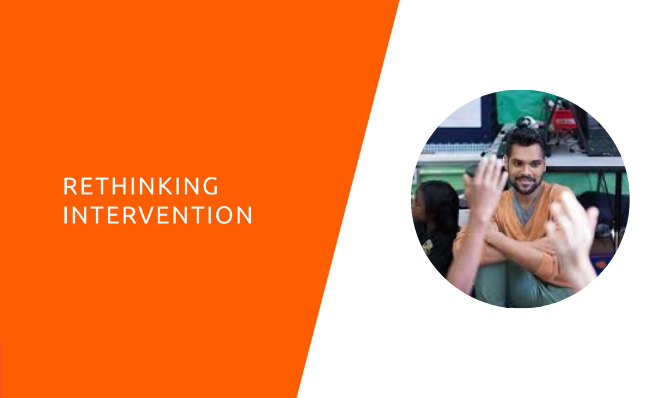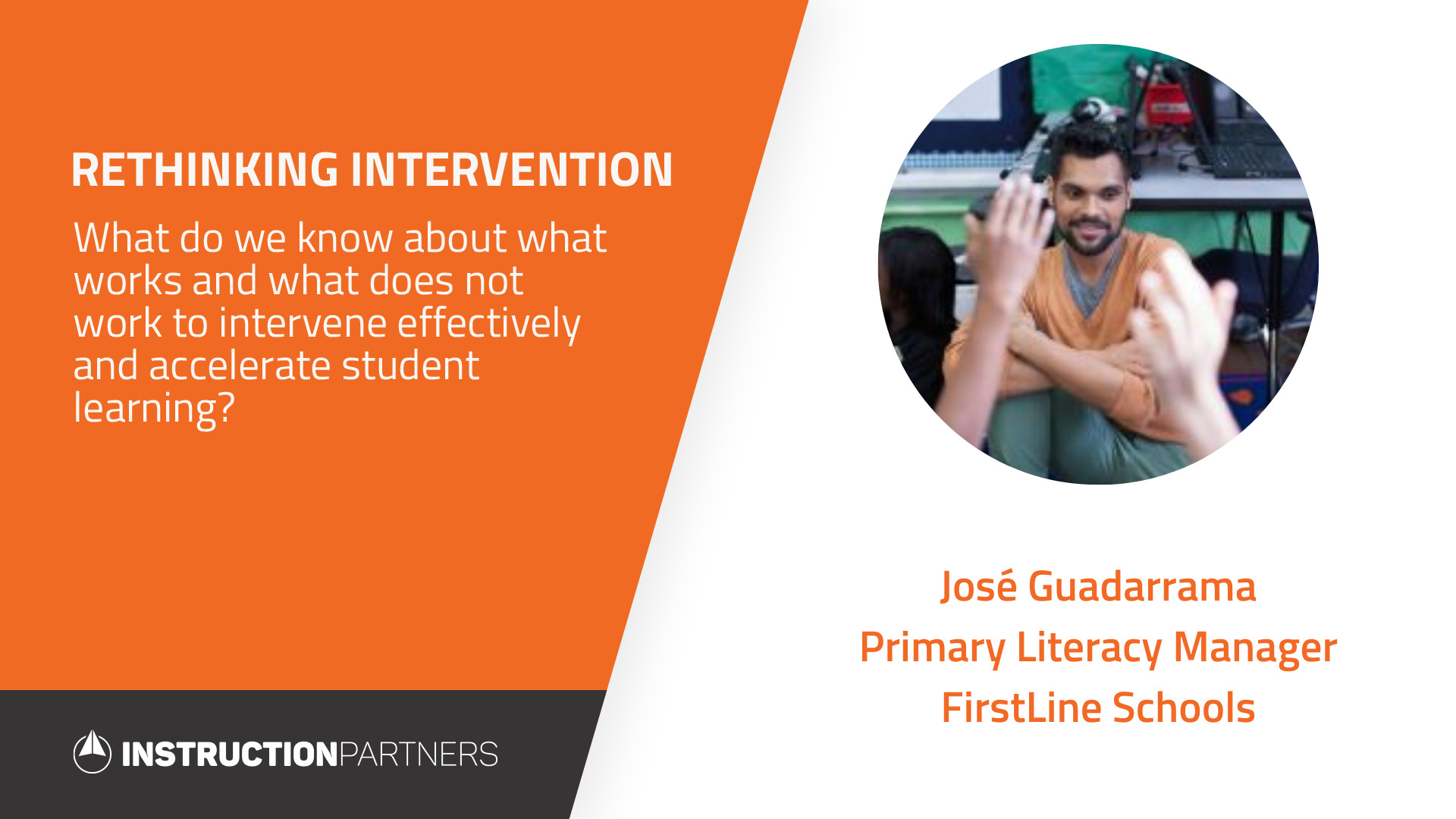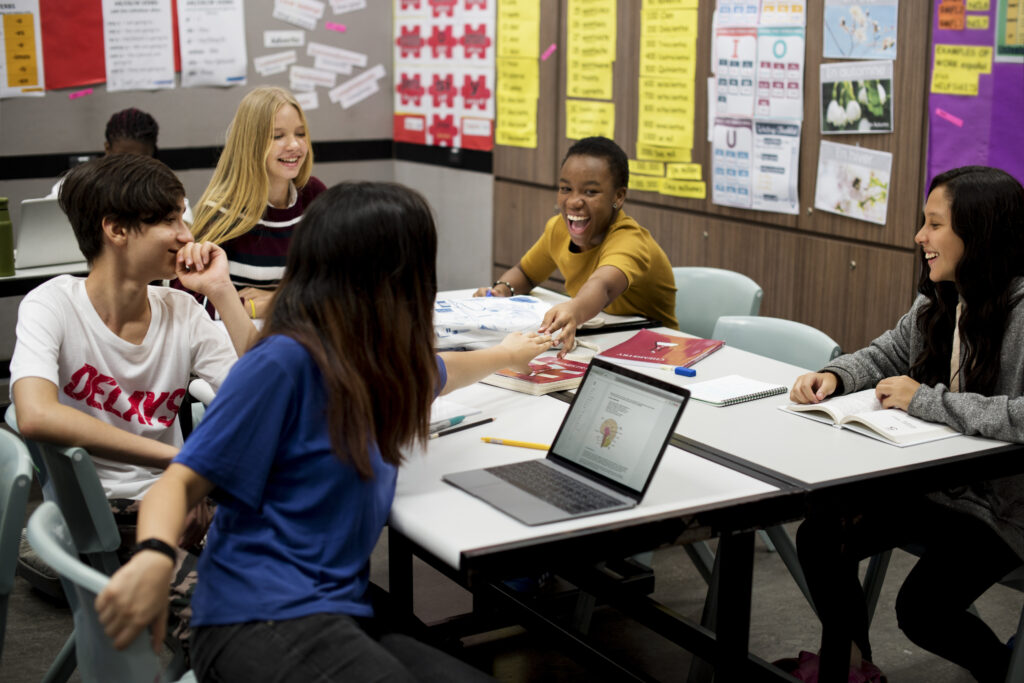
José Guadarrama, FirstLine Schools
José Guadarrama is the Primary Literacy Content Leader for FirstLine Schools, a five charter management organization in New Orleans, where he has taught for seven years. For the past three years, he has designed and managed the effectiveness of curriculum-based professional learning for kindergarten through fourth-grade teachers.
Elizabeth Ramsey, Senior Managing Director of Program at Instruction Partners, spoke to José about best practices to intervene effectively and accelerate student learning in K–2 ELA.
Watch the full conversation or read the abridged Q&A below.

ER: Tell us about a student that you’ve worked with and how that story informs your perspective about accelerating student learning.
JG: I have been teaching in New Orleans for 10 years. I traveled back 10 years ago and thought about the student Timothy. When I worked with him as a third-grader, Timothy had an incredible amount of kindness and integrity for an eight-year-old, and personal investment for learning that was just remarkable. He was very personable, he had strong relationships with peers and adults. One of the things I remember about Timothy is that he had such a clear growth mindset about himself and others. When we started third grade together, we as a school were using a guided reading approach to reading instruction. And so he began the year at a first-grade reading level. I was concerned because he was beginning the year almost a couple of years behind.
it’s important to have some context here. We were a new charter, we had new leaders. We were very hungry to learn. We had school goals that were anchored by the progression in guided reading. Our interventions were really based on the pace and rate at which students progressed in the guided reading. Students’ reading gaps were articulated using the guided reading program. Overall, our theory around reading was based on guided reading, which wasn’t research-based. And I think in a lot of ways it reflected an incomplete understanding of how skill reading is developed.
And so come back to Tim’s experience in third grade. He early on was designated as a student that was Tier 3, which meant that he was going to receive a lot of support, more time with teachers, small group instruction, and good teaching practices such as scaffolded questions during the whole group. What most stands out is that his intervention experience was designated by his tier, not necessarily by skill gaps that he had. And so to think forward a year and look where Tim ended the third-grade experience, he actually made a lot of growth. But I think that growth is really reflective of quick wins. He memorized words. He didn’t really learn how to decode.
And so I come to that anecdote because though his experience was 10 years ago, I do think it serves as an anecdote that captures most of our schools where they are in terms of attending to unfinished learning. When it comes to reading, our intervention is predicated on an unclear or fully unrealized theory of action in terms of how skilled reading is developed. A lot of times the interventions are kind of like maps or paint by numbers. Like, “If you’re Tier 2, you receive this intervention and these supports. If you’re Tier 3, you receive these supports.” And they don’t drive towards a clear purpose in a systematic way. I know that to resolve unfinished learning, we need to work towards a clear purpose in terms of what reading is and then we need to know how to arrive at that purpose. To understand the purpose, we need to understand what schooling is. And then to move systematically, we need to understand the developmental pathway and make sure that those two things are clear to every person in the building so that when we are approaching unfinished learning, we’re approaching cohesively.
ER: I really appreciate you sharing your wisdom and also sharing a vulnerable story about something that you think could be improved.
Thinking about this fall, we are in a unique time in many ways. I’d love to hear what you see as the key challenges that teachers need to be prepared for.
JG: First, developing strong partnerships with families, with colleagues, and with school leaders, because this is a turbulent time. I feel a deep sense of pride in our approach to distance learning in New Orleans and at FirstLine and I think part of that pride is contingent on not losing sight of what is actually going on. To ask folks to show up on a screen or the phone with learning materials in front of them, and turn a blind eye to the reality that is this pandemic—that’s something that we have not done. We are acknowledging the pandemic and how it’s impacting people in different ways. The first challenge is not losing sight of that. Our job is to educate people, but our job primarily is to make sure that we are keeping each other safe and a part of that is not only being prepared to teach but also being prepared to learn more about your relationships.
The second piece would be that the learning and teaching context is so different now. In these partnerships with families, with colleagues, with school leaders across schools, we need to clearly define what learning is. One thing that I’ve been really excited about is when I’m in classrooms with teachers is that I see so many students’ families. They’re in there and helping their scholar do the work. They don’t want their child to fail regardless of what’s going on in the world. And that to me, it gives me a piece of data that we might need a shared understanding of what learning is. Learning is an iterative process. Learning means that a student will not be successful the first time, the second time, the third time, and that’s okay. And so how are we talking about learning among families so that when a family member sees their child not apply a skill the first time that they’ve learned it, we say that is okay? And how do we make sure that we frame learning as almost a metacognitive process of being aware of, “Oh, this is how I made a mistake. And this is where I need to be.” That analysis of the dissonance is where the learning really holds.
I think that there’s an opportunity to develop a shared understanding of what learning is and what it isn’t. I think that students are leading us to understanding what engagement looks like. And we need to lean into that. As a teacher I have some knowledge and some experience and some skill to facilitate the learning in the class—I feel pretty confident. But I also see students as teaching us what they need in terms of how to be engaged in this virtual context.
Another challenge is that we need to continue to develop a deep understanding of content. We look at the standards and the standards clearly define the skills and knowledge aspects. As teachers and school leaders, we need to make sure that we’re continuing to develop our understanding of what those things are. So that we are communicating that to parents or family members and students.
And it differs by grade. In kindergarten or first grade, families need to know that when I’m reading this book out loud, this is something that I don’t necessarily need students to read because it contains words that they haven’t been taught how to read yet, and that is okay. But when we’re reading this decodable, that’s where we really want to make sure that the kid’s brain is sweating.
And to return to the challenge—again, establish strong partnerships across colleagues and peers and families and leaders, and really contextualize where we are in the world. We are in this unique time. But continue to learn how to engage students and continue to develop that deep sense of content so that when we talk about learning, we’re not only acknowledging the difference in terms of the virtual or distance learning context, but also acknowledging what remains to be true, because the standards tell us what remains to be true.
ER: So in thinking about the fall, we have this challenge around accelerating learning. That has always been a challenge, but it’s exacerbated during this time. What do you think the best practices are here? What have you seen that works at schools that teachers should be thinking about?
JG: I think about moments where I did the best work here. It really was contingent on me being a really strong team member. I remember there was a time when before school started, as a third-grade teacher, I would need to connect with my second-grade teachers, and not only learn the major work of their grades so to speak, but then also learn at a very granular context where students were coming into my grade from second grade.
What I learned through that process was there were some really critical things in second grade that connected to the third-grade experience. And there are some things that frankly were kind of unique to K–2. And that helped us understand better the work that we were doing that year. Now, I did the same thing with my third graders that were going to fourth grade. And I think that helped draw the parameters—clear, bright lines around, to borrow this term from math right, “the major work” of third grade. Because I’m thinking about students like Timothy that maybe a couple of years behind entering third grade, and there are some things in first or second grade that I’m just not going to prioritize for Tim, because that’s not necessarily going to help him access the content in third grade or in fourth grade. And so when thinking about accelerating learning, I also think about making sure we get really granular about what learning means, in particular grade levels, and how that learning is set up by the previous grade and where it’s going in the grade to come.
ER: Have you been thinking about building background knowledge in elementary reading?
JG: Sure. This comes back to the initial question around: How is skilled reading developed? I think that is part of what needs to be learned from a teacher’s perspective. It’s that it’s not just decoding in K–2, right? We know that students are able to comprehend and discuss complex texts, but they’re not able to read it independently. It’s kind of like a mathematical equation: Decoding multiplied by language comprehension equals reading comprehension. And so as a K–2 teacher, where does knowledge building fit in there? It’s in the language comprehension piece. Though the standards ask for the foundational skills standards to be mastered in the K–1 band, that doesn’t mean that there aren’t informational and literary standards because those attend to different muscles in a reader’s brain that are necessary in order for skilled reading to be developed. In order for a third grader to enter at grade level, they need to have had those knowledge-based read alouds so that they can access the content in the grade they’re coming into. It really hangs on the degree to which a teacher is understanding what skilled reading is and how it’s developed, in an almost theoretical sense. And then how does the reading program at this school fit so I can see how each part of the reading experience in a student’s day contributes to that overall belief?
ER: What have you seen that doesn’t work? And what are the things that give you pause or nervousness about next year that you want to see folks avoid?
JG: I’m seeing and hearing things that I thought we had left behind, things like skills chasing. So when thinking about third and fourth grade, for example, I’m hearing, “How are we going to reteach our character motivations when at the exit ticket level, a student has demonstrated that they don’t yet understand how a character’s motivations contribute to the sequence of events?” I’m not trying to downplay the importance of data or even the importance of re-teaching. What I want to make sure we’re avoiding is this kind of standards-chasing aspect as opposed to taking a step back and seeing this multi-variable equation at work. That character motivation lesson is but one variable in a larger experience a student is having in terms of reading development. I asked that character motivation question at the exit ticket level, but how else am I stepping back to see the other components that together will actually give me a more accurate picture of the degree to which a reader is developing within a year?
I also am getting a sense that we’re wanting to make sure that we’re maximizing our beginning of year assessments, our screeners and our diagnostic assessments. I think that we have much work to do there. A big challenge that we need to attend to is being able to answer the degree to which these assessments are informing instructional pivots. For example, when a student in the beginning of the year takes a map assessment. I really respect the data that map assessment gives based on national norms, like you can get really granular with this data. However, to what degree as a teacher am I using that data to plan my next day’s lesson? Should I be? The answer for me is no.
But think about the degree to which a teacher is hearing that across all levels…does a school leader know how to say that? Does the school director or CAO understand the place and purpose of those beginning of year assessments? It’s great that we’re wanting to maximize our beginning of year assessment data, but we need to make sure that we completely understand the purpose of those assessments and the limits of them, so that we don’t then overload teachers with a lot of data that isn’t necessarily actionable on a day-to-day basis.
ER: Is there anything else that you just want to leave us with to think about this fall?
JG: We’re moving forward in these unprecedented times and the way that we’ve come together to collaborate on behalf of our students is incredible. We should always start with that that in mind. Whenever we begin the work, we always need to have our students at the center. Answering what is going to be the best student experience to get them ready for the next year and treating them as a whole person should always be where we begin conversations and where we end them.


